Submitted:
31 May 2023
Posted:
31 May 2023
You are already at the latest version
Abstract
Keywords:
1. Introduction
2. Materials and Methods
2.1. Research Site and Data Collection
2.2. Method
2.3. Machine learning models
2.3.1. Random Forest (RF)
2.3.2. Extreme Gradient Boosting (XGB)
2.3.3. Light Gradient Boosting (LGB)
2.3.4. K-fold cross-validation
2.3.5. Model evaluation
3. Results and Discussion
4. Conclusions
Author Contributions
Funding
Conflicts of Interest
Appendix A. OSM Code Blocks
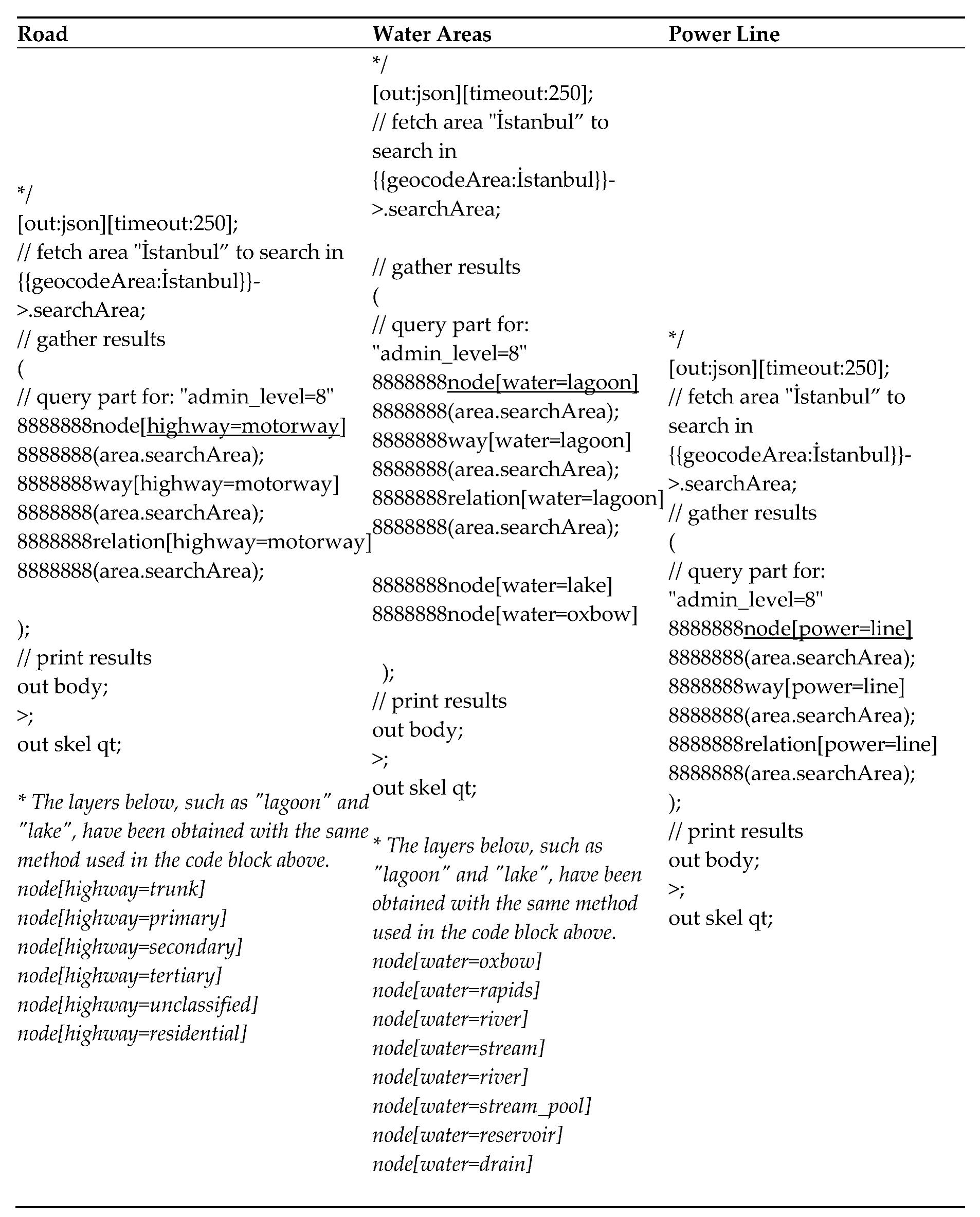 |
References
- Sari, F. Identifying anthropogenic and natural causes of wildfires by maximum entropy method-based ignition susceptibility distribution models. J. Forestery Res. 2022, 1–17. [Google Scholar] [CrossRef]
- Vacchiano, G.; Foderi, C.; Berretti, R.; Marchi, E.; Motta, R. Modeling anthropogenic and natural fire ignitions in an inner-alpine valley. Nat. Hazard. Earth Sys. 2018, 18, 935–948. [Google Scholar] [CrossRef]
- Romps, D.M.; Seeley, J.T.; Vollaro, D.; Molinari, J. Projected increase in lightning strikes in the United States due to global warming. Science 2014, 346, 851–854. [Google Scholar] [CrossRef] [PubMed]
- Balch, J.K.; Bradley, B.A.; Abatzoglou, J.T.; Nagy, R.C.; Fusco, E.J.; Mahood, A.L. Human-started wildfires expand the fire niche across the United States. Proc. Natl. Acad. Sci. 2017, 114, 2946–2951. [Google Scholar] [CrossRef] [PubMed]
- Bento-Gonçalves, A.; Vieira, A. Wildfires in the wildland-urban interface: Key concepts and evaluation methodologies. Sci. Total Environ. 2020, 707, 135592. [Google Scholar] [CrossRef]
- Hoang, T.V.; Chou, T.Y.; Fang, Y.M.; Nguyen, N.T.; Nguyen, Q.H.; Canh, P.X.; Toan, D.N.B.; Nguyen, X.L.; Meadows, M.E. Mapping Forest Fire Risk and Development of Early Warning System for NW Vietnam Using AHP and MCA/GIS Methods. Appl. Sci. 2020, 10, 4348–4366. [Google Scholar] [CrossRef]
- Kumari, B.; Pandey, A.C. Geo-imformatics based multi-criteria decision analysis (MCDA) through analytic hierarchy process (AHP) for forast fire risk mapping in Palamau Tiger Reserve, Jharkhand state, India. J. Earth Syst. Sci. 2020, 129, 204. [Google Scholar] [CrossRef]
- Fekir, Y.; Hamadouche, M.A.; Anteur, D. Integrated approach for the assessment of forest fire risk and burn severity mapping using GIS, AHP method, and Google Earth Engine in Western Algeria. Euro-Mediterranean J. Environ. Integ. 2022, 1–14. [Google Scholar] [CrossRef]
- Novo, A.; Fariñas-Álvarez, N.; Martínez-Sánchez, J.; González-Jorge, H.; Fernández-Alonso, J.M.; Lorenzo, H. Mapping forest fire risk—A case study in Galicia (Spain). Remote Sens. 2020, 12, 3705. [Google Scholar] [CrossRef]
- Liu, Y.; Lu, H.; Tian, P.; Qiu, L. Evaluating the effects of dams and meteorological variables on riparian vegetation NDVI in the Tibetan Plateau. Sci. Total Environ. 2022, 831, 154933. [Google Scholar] [CrossRef]
- Vinayak, B.; Lee, H.S.; Gedam, S.; Latha, R. Impacts of future urbanization on urban microclimate and thermal comfort over the Mumbai metropolitan region, India. Sustain. Cities Soc. 2022, 79, 103703. [Google Scholar] [CrossRef]
- Ajin, R.; Loghin, A.-M.; Vinod, P.; Jacob, M. Forest Fire Risk Zone Mapping Using RS and GIS Techniques: A Study in Achankovil Forest Division, Kerala, India. J. Earth, Environ. Health Sci. 2016, 2, 109. [Google Scholar] [CrossRef]
- Akay, A.E. Integrated Use of AHP and GIS Techniques for Generating Forest Fire Risk Map in Karacabey Flooded Forest. Environ. Sci. Proc. 2021, 3, 62. [Google Scholar] [CrossRef]
- Akay, A.E.; Şahin, H. Forest Fire Risk Mapping by using GIS Techniques and AHP Method: A Case Study in Bodrum (Turkey). European J. Forest Eng. 2019, 25–35. [Google Scholar] [CrossRef]
- Akbulak, C.; Tatlı, H.; Aygün, G.; Sağlam, B. Forest fire risk analysis via integration of GIS, RS and AHP: The Case of Çanakkale, Turkey. J. Hum. Sci. 2018, 15, 2127. [Google Scholar] [CrossRef]
- Cetin, M.; Isik Pekkan, Ö.; Ozenen Kavlak, M.; Atmaca, I.; Nasery, S.; Derakhshandeh, M.; Cabuk, S.N. GIS-based forest fire risk determination for Milas district, Turkey. Nat. Hazards 2022, 0123456789. [Google Scholar] [CrossRef]
- Chavan, M.E.; Das, K.K.; Suryawanshi, R.S. Forest fire risk zonation using Remote Sensing and GIS in Huynial watershed, Tehri Garhwal district, UA. Int. J. Basic Appl. Res. 2012, 02, 6–12. [Google Scholar]
- Jaiswal, R.K.; Mukherjee, S.; Raju, K.D.; Saxena, R. Forest fire risk zone mapping from satellite imagery and GIS. Int. J. Appl. Earth Observ. Geoinf. 2002, 4, 1–10. [Google Scholar] [CrossRef]
- Kayet, N.; Chakrabarty, A.; Pathak, K.; Sahoo, S.; Dutta, T.; Hatai, B.K. Comparative analysis of multi-criteria probabilistic FR and AHP models for forest fire risk (FFR) mapping in Melghat Tiger Reserve (MTR) forest. J. Forestry Res. 2020, 31, 565–579. [Google Scholar] [CrossRef]
- Lamat, R.; Kumar, M.; Kundu, A.; Lal, D. Forest fire risk mapping using analytical hierarchy process (AHP) and earth observation datasets: A case study in the mountainous terrain of Northeast India. SN Appl. Sci. 2021, 3, 1–15. [Google Scholar] [CrossRef]
- Mohammadi, F.; Bavaghar, M.P.; Shabanian, N. Forest Fire Risk Zone Modeling Using Logistic Regression and GIS: An Iranian Case Study. Small-Scale For. 2014, 13, 117–125. [Google Scholar] [CrossRef]
- Naskar, S.; Rahaman, A.; Biswas, B. Forest Fire Susceptibility Mapping of West Sikkim District, India using MCDA techniques of AHP & TOPSIS model. Res. Square 2022, 1–23. [Google Scholar] [CrossRef]
- Nikhil, S.; Danumah, J.H.; Saha, S.; Prasad, M.K.; Rajaneesh, A.; Mammen, P.C.; Ajin, R.S.; Kuriakose, S.L. Correction to: Application of GIS and AHP Method in Forest Fire Risk Zone Mapping: A Study of the Parambikulam Tiger Reserve, Kerala, India. J. Geovisualization Spat. Anal. 2021, 5, 1. [Google Scholar] [CrossRef]
- Nuthammachot, N.; Stratoulias, D. Multi-criteria decision analysis for forest fire risk assessment by coupling AHP and GIS: Method and case study. Environ. Dev. Sustain. 2021, 23, 17443–17458. [Google Scholar] [CrossRef]
- Nuthammachot, N.; Stratoulias, D. A GIS- and AHP-based approach to map fire risk: A case study of Kuan Kreng peat swamp forest, Thailand. Geocarto Int. 2021, 36, 212–225. [Google Scholar] [CrossRef]
- Özşahin, E. Forest Fire Susceptibility Analysis Using Gis and Ahp: The Case of Antakya Forestry Operation Directorate, Cbs ve Ahs Kullanılarak Orman Yangını Duyarlılığı Anali̇zi̇: Antakya Orman İşletme Müdürlüğü Örneği̇. Route Edu. Social Sci. J. 2014, 1, 50–71. [Google Scholar] [CrossRef]
- Pandey, K.; Ghosh, S.K. Modeling of parameters for forest fire risk zone mapping. Int. Archives Photogramm., Remote Sens. Spatial Inf. Sci.-ISPRS Archives 2018, 42, 299–304. [Google Scholar] [CrossRef]
- Qtaishat, K.; Shatnawi, N.; Habib, M. Forest Fire Risk Zonation Using Remote Sensing and GIS Technology “Case study in Jordan”. Forest Fire Int. J. Environ. Global Climate Change 2017, 5, 1–8. [Google Scholar]
- Rahmani, S.; Benmassoud, H. Modelling of forest fire risk spatial distribution in the region of Aures, Algeria. Geoadria 2019, 24, 79–92. [Google Scholar] [CrossRef]
- Setiawan, I.; Mahmud, A.R.; Mansor, S.; Mohamed Shariff, A.R.; Nuruddin, A.A. GIS-grid-based and multi-criteria analysis for identifying and mapping peat swamp forest fire hazard in Pahang, Malaysia. Disaster Prev. Manag: An Int. J. 2004, 13, 379–386. [Google Scholar] [CrossRef]
- Sivrikaya, F.; Küçük, Ö. Modeling forest fire risk based on GIS-based analytical hierarchy process and statistical analysis in Mediterranean region. Ecol. Inform. 2022, 68. [Google Scholar] [CrossRef]
- Soydan, O. Determination of Forest Fire Risk Using GIS: A Case Study in Nigde, Turkey. Bartın Orman Fakültesi Dergisi 2022, 24, 77–94. [Google Scholar] [CrossRef]
- Suryabhagavan, K.V.; Alemu, M.; Balakrishnan, M. Gis-based multi-criteria decision analysis for forest fire susceptibility mapping: A case study in Harenna forest, southwestern Ethiopia. Trop. Ecol. 2016, 57, 33–43. [Google Scholar]
- Van Hoang, T.; Chou, T.Y.; Fang, Y.M.; Nguyen, N.T.; Nguyen, Q.H.; Canh, P.X.; Toan DN, B.; Nguyen, X.L.; Meadows, M.E. Mapping forest fire risk and development of early warning system for NW vietnam using AHP and MCA/GIS methods. Appl. Sci. 2020, 10, 1–19. [Google Scholar] [CrossRef]
- The State of the World Forests-Forests, Biodiversity and People, 2020, Food and Agriculture Organization of the United Nation. Available online: https://www.fao.org/3/ ca8642en/ca8642en.pdf (accessed in 03 May 2023).
- Chuvieco, E.; Congalton, R. Application of Remote Sensing and Geographic Information Systems to Forest Fire Hazard Mapping, Remote Sens. Environ. 1989, 29, 147–159. [Google Scholar] [CrossRef]
- Eskandari, S.; Chuvieco, E. Fire danger assessment in Iran based on geospatial information. Int. J. Appl. Earth Observ. Geoinf. 2015, 42, 57–64. [Google Scholar] [CrossRef]
- Yakubu, I.; Mireku-Gyimah, D.; Duker, A.A. Review of methods for modelling forest fire risk and hazard. Afr. J. Environ. Sci. Technol. 2015, 9, 155–165. [Google Scholar] [CrossRef]
- Turkish Statistical Instutie (TUIK), Population and Demography Database. 2022. Available online: https://data.tuik.gov.tr (accessed in 10 May 2023).
- Gürel, A.; Balta, Y. İstanbul’ un göç olayı ve etnik hayat üzerine. Marmara Sosyal Araştırmalar Dergisi 2011, 1, 1–15. [Google Scholar]
- Kubat, A.S.; Hazar, D. İstanbul’un Çeper Kuşak Gelişim Süreci. Türkiye Kentsel Morfoloji Ağı 2018, 693-711. ISBN: 978-605-80820-1-4.
- İstanbul Ekonomisi. İstanbul Büyükşehir Belediyesi, İstanbul Planlama Ajansı, İstanbul İstatistik Ofisi. 2021. Available online: https://ipa.istanbul/wp-content/uploads/2021/08 /son-verilerle-i-stanbul-ekonomisi-2021-1-c-eyrek.pdf (accessed in 13 May 2023) (In Turkish).
- Dinçer, İ.; Enlil, Z.; Evren, Y. İstanbul’ un koruma alanlarının değerlendirilmesi. Megaron 2009, 3. [Google Scholar]
- Üstün, A.K.; Angün, A.S. İstanbul'un ilçelerinin afet yönetimi açısından önem ağırlıklarının analitik hiyerarşi süreci kullanılarak belirlenmesi. Gazi Üniversitesi Mühendislik Mimarlık Fakültesi Dergisi 2016, 31. [CrossRef]
- Atmiş, E.; Tolunay, D.; Erdönmez, C. Bölüm I-II, Orman Yangınlarının Sayısal Analizi, Orman Yangınları, Kavgacı, A., Başaran, M.A. (Editors), Türkiye Ormancılar Derneği Yayını 2023, 422 s. Ankara, ISBN: 978-605-71791-4-2.
- Xie, Y.; Peng, M. Forest fire forecasting using ensemble learning approaches. Neural Comput. Appl. 2019, 31, 4541–4550. [Google Scholar] [CrossRef]
- Pourghasemi, H.R.; Kariminejad, N.; Amiri, M.; Edalat, M.; Zarafshar, M.; Blaschke, T.; Cerda, A. Assessing and mapping multi-hazard risk susceptibility using a machine learning technique. Sci. Rep. 2020, 10, 3203. [Google Scholar] [CrossRef] [PubMed]
- Rubí, J.N.; de Carvalho, P.H.; Gondim, P.R. Application of machine learning models in the behavioral study of forest fires in the Brazilian Federal District region. Eng. Appl. Artif. Intel. 2023, 118, 105649. [Google Scholar] [CrossRef]
- Lu, Y.; Fan, X.; Zhao, Z.; Jiang, X. Dynamic Fire Risk Classification Prediction of Stadiums: Multi-Dimensional Machine Learning Analysis Based on Intelligent Perception. Appl. Sci. 2022, 12, 6607. [Google Scholar] [CrossRef]
- Pang, Y.; Li, Y.; Feng, Z.; Feng, Z.; Zhao, Z.; Chen, S.; Zhang, H. Forest Fire Occurrence Prediction in China Based on Machine Learning Methods. Remote Sens. 2022, 14, 5546. [Google Scholar] [CrossRef]
- Mohajane, M.; Costache, R.; Karimi, F.; Bao Pham, Q.; Essahlaoui, A.; Nguyen, H.; Oudija, F. Application of remote sensing and machine learning algorithms for forest fire mapping in a Mediterranean area. Ecol. Indic. 2021, 129, 107869. [Google Scholar] [CrossRef]
- Dwiasnati, S.; Devianto, Y. Classification of forest fire areas using machine learning algorithm. World J. Adv. Eng. Technol. Sci. 2021, 3, 008–015. [Google Scholar] [CrossRef]
- Ercan, U. Estimating of Households Shopping on The Internet Using Random Forest Method. Kafkas Üniversitesi İktisadi ve İdari Bilim Fakültesi Dergisi 2021, 12, 728–752. [Google Scholar] [CrossRef]
- Ercan, U. Determining Airline Customer Satisfaction with Ensemble Learning Methods. Alanya Acad. Rev. 2022, 6, 2763–2774. [Google Scholar] [CrossRef]
- Kalantar, B.; Ueda, N.; Idrees, M.O.; Janizadeh, S.; Ahmadi, K.; Shabani, F. Forest fire susceptibility prediction based on machine learning models with resampling algorithms on remote sensing data. Remote Sens. 2020, 12, 3682. [Google Scholar] [CrossRef]
- Gürel, A.; Gündüz, A.E. İstanbul’ un Ekolojik Yapısı Üzerine Bir Araştırma. Marmara Sosyal Araştırmalar Dergisi 2011, 1-12.
- Overpass Turbo. 2022. Available online: http://overpass-turbo.eu (accessed in 10 May 2023).
- Esri, Sentinel-2 Land Cover Explorer. 2022. Available online: https://livingatlas.arcgis. com/landcoverexplorer/ (accessed in 10 May 2023).
- Breiman, L. Random forests. Mach. Learn. 2001, 45, 5–32. [Google Scholar] [CrossRef]
- Chen, T.; Guestrin, C. Xgboost: A scalable tree boosting system. In Proceedings of the 22nd acm sigkdd international conference on knowledge discovery and data mining 2016, 785-794. [CrossRef]
- Fan, J.; Ma, X.; Wu, L.; Zhang, F.; Yu, X.; Zeng, W. Light Gradient Boosting Machine: An efficient soft computing model for estimating daily reference evapotranspiration with local and external meteorological data. Agr. Water Manag. 2019, 225, 105758. [Google Scholar] [CrossRef]
- Jain, P.; Coogan, S.C.; Subramanian, S.G.; Crowley, M.; Taylor, S.; Flannigan, M.D. A review of machine learning applications in wildfire science and management. Environ. Rev. 2020, 28, 478–505. [Google Scholar] [CrossRef]
- Rodrigues, M.; De la Riva, J. An insight into machine-learning algorithms to model human-caused wildfire occurrence. Environ. Modell. Softw. 2014, 57, 192–201. [Google Scholar] [CrossRef]
- Tehrany, M.S.; Jones, S.; Shabani, F.; Martínez-Álvarez, F.; Tien Bui, D. A novel ensemble modeling approach for the spatial prediction of tropical forest fire susceptibility using LogitBoost machine learning classifier and multi-source geospatial data. Theor. Appl. Climatol. 2019, 137, 637–653. [Google Scholar] [CrossRef]
- Michael, Y.; Helman, D.; Glickman, O.; Gabay, D.; Brenner, S.; Lensky, I.M. Forecasting fire risk with machine learning and dynamic information derived from satellite vegetation index time-series. Sci. Total Environ. 2021, 764, 142844. [Google Scholar] [CrossRef]
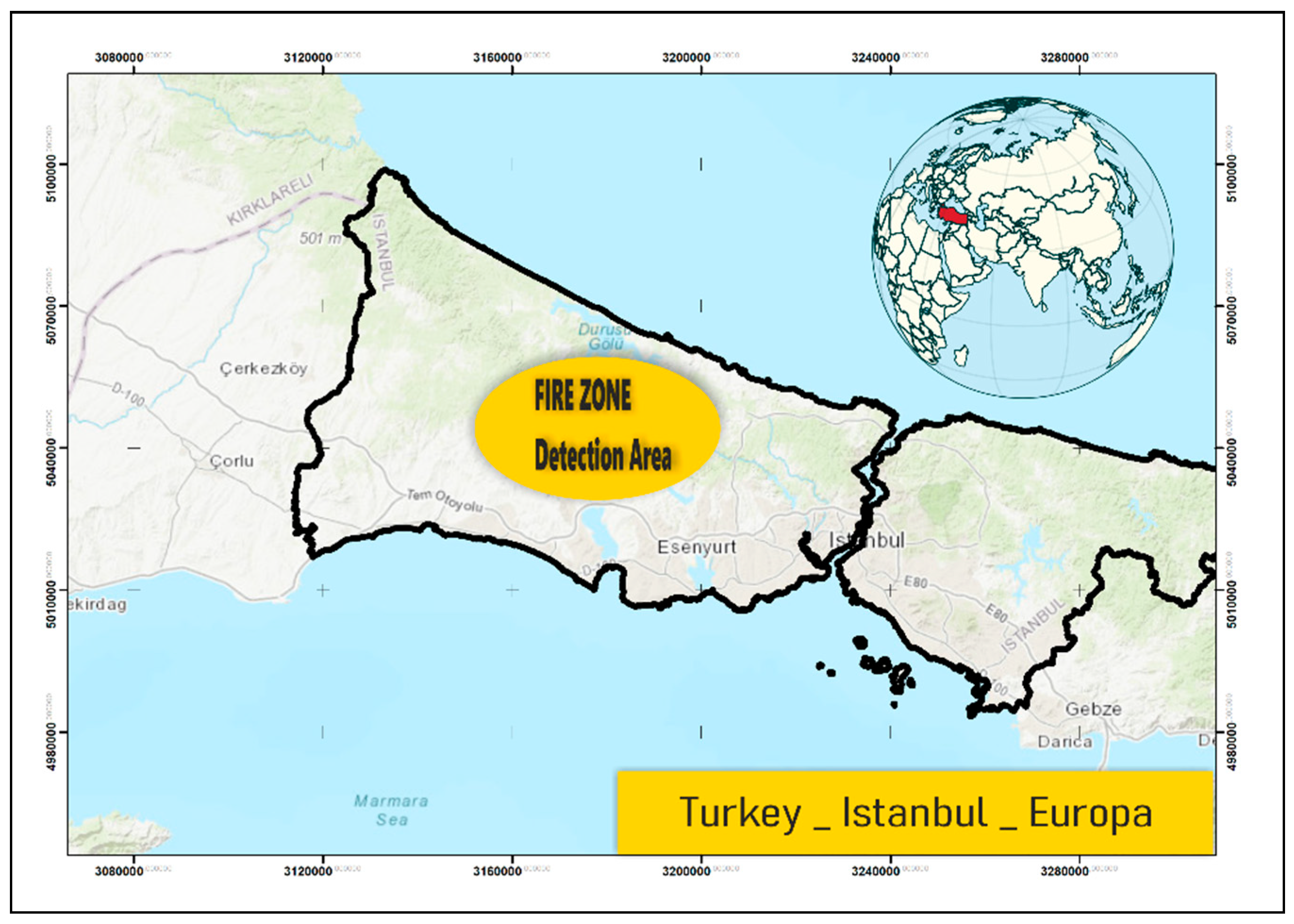
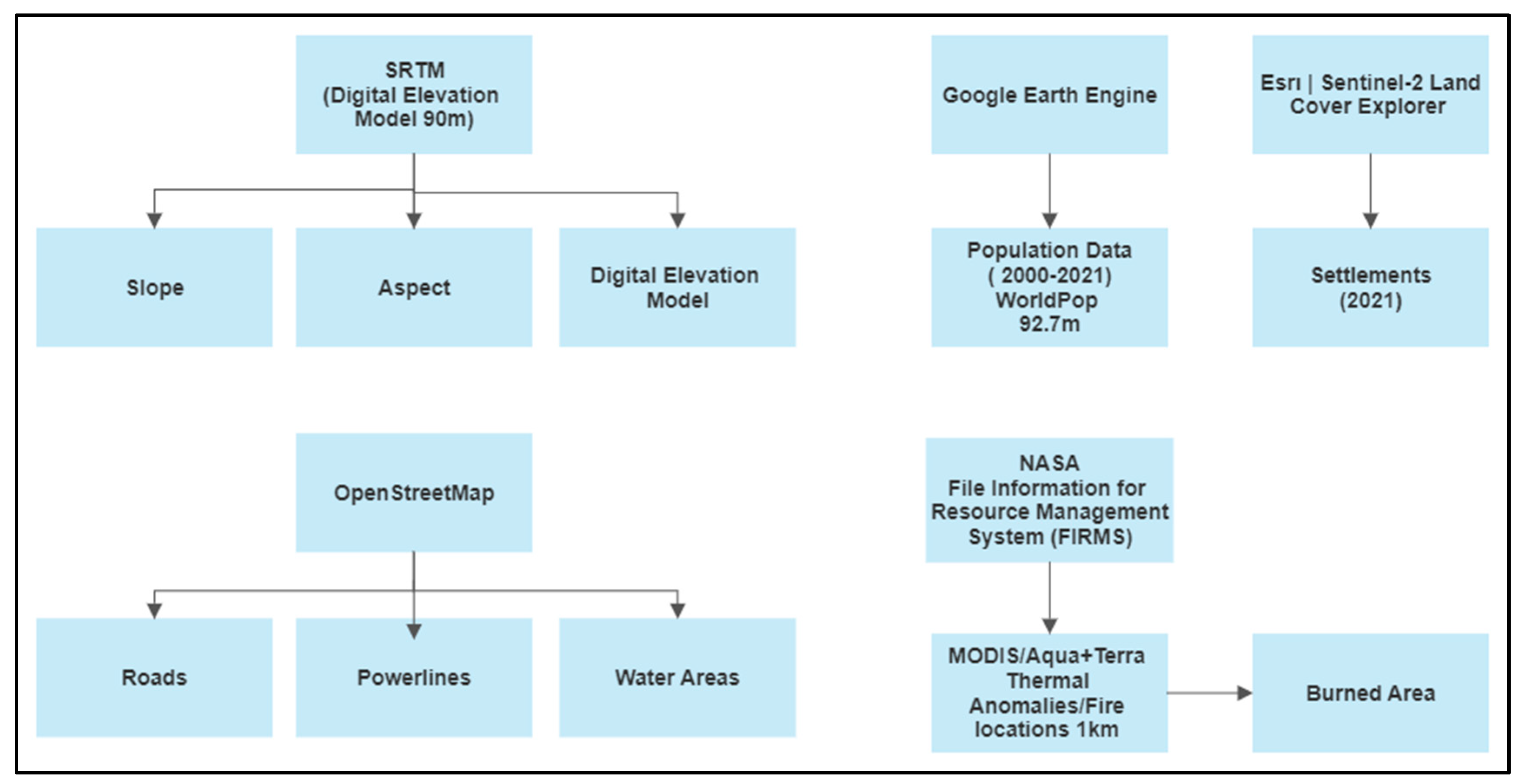
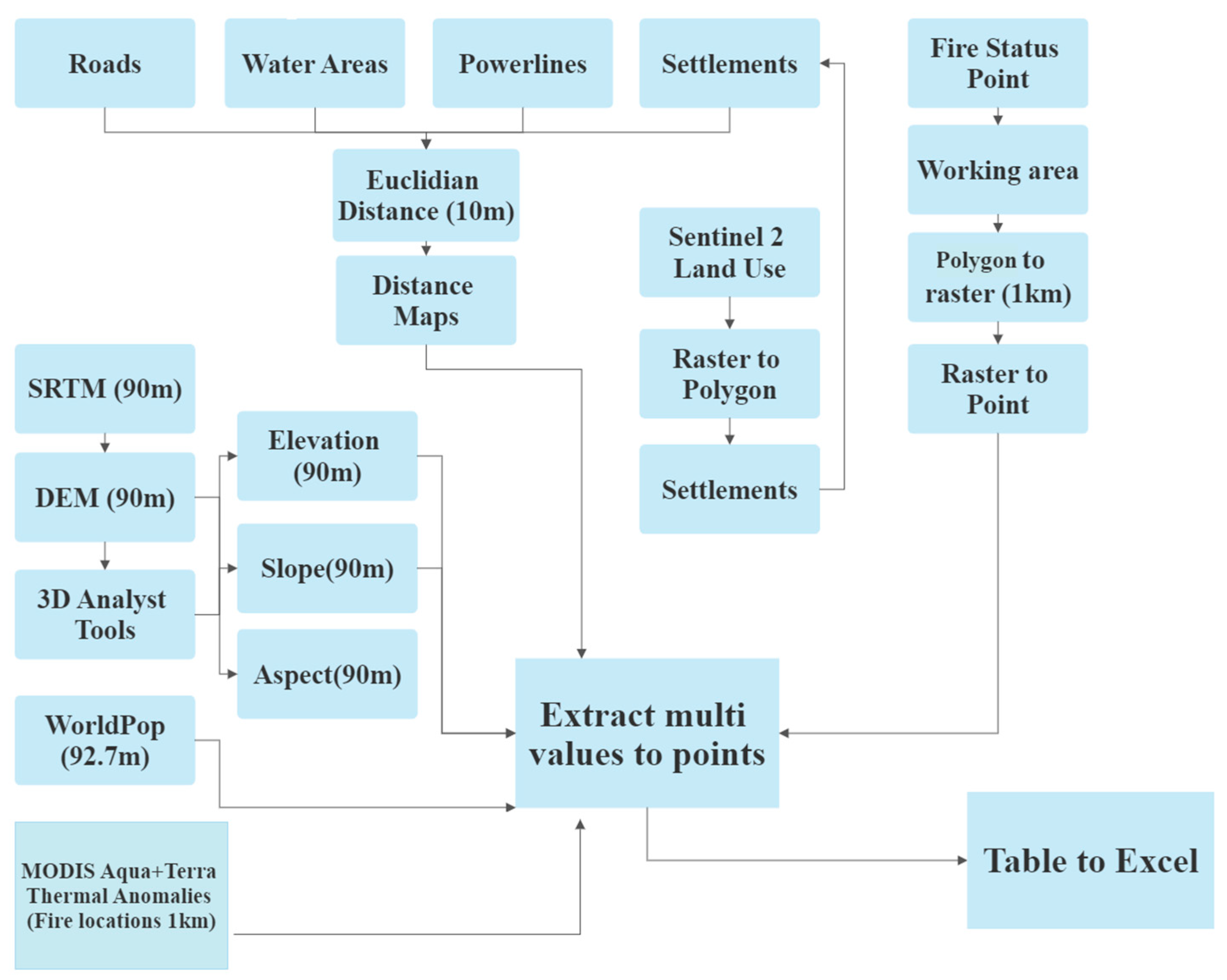
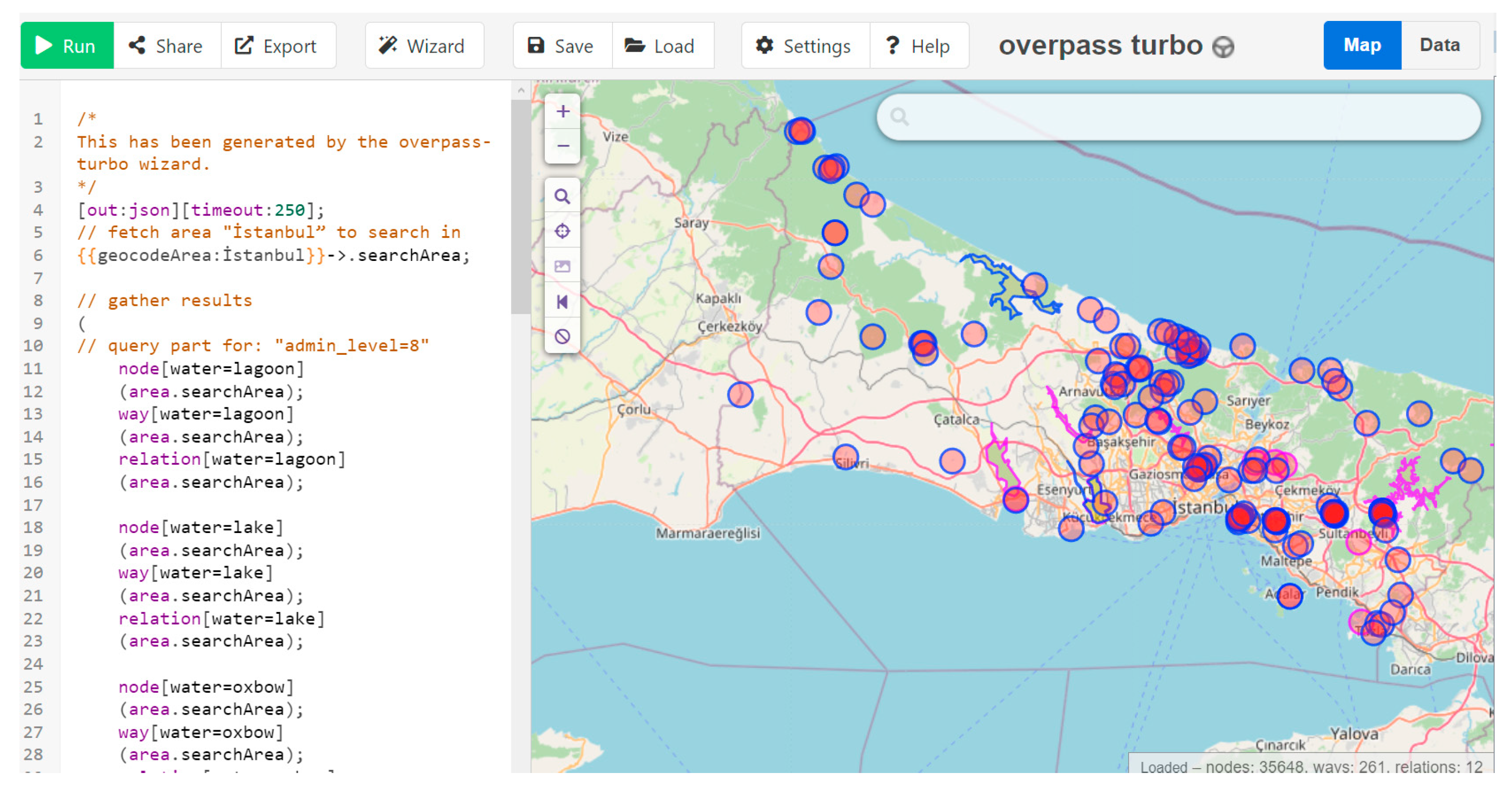
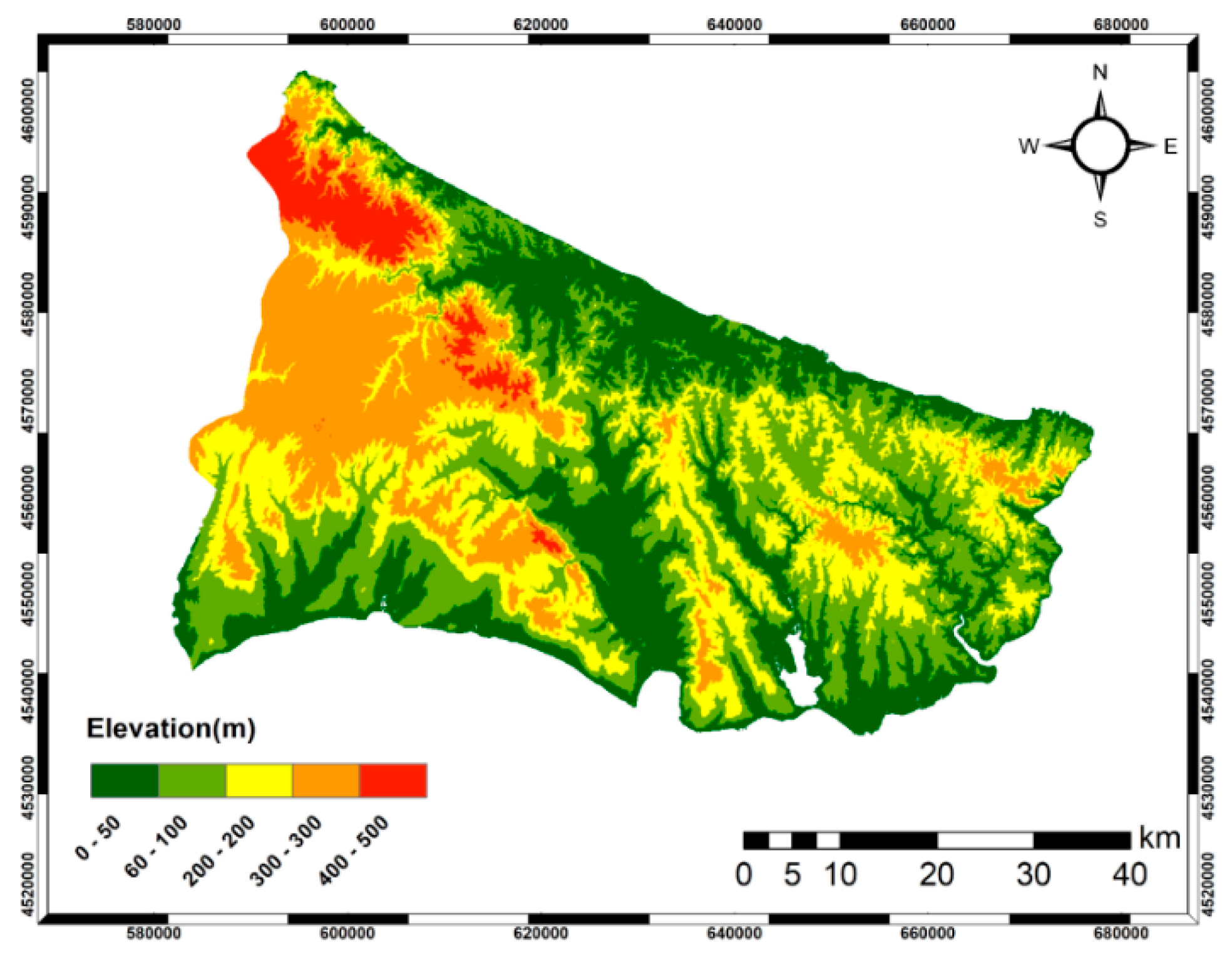
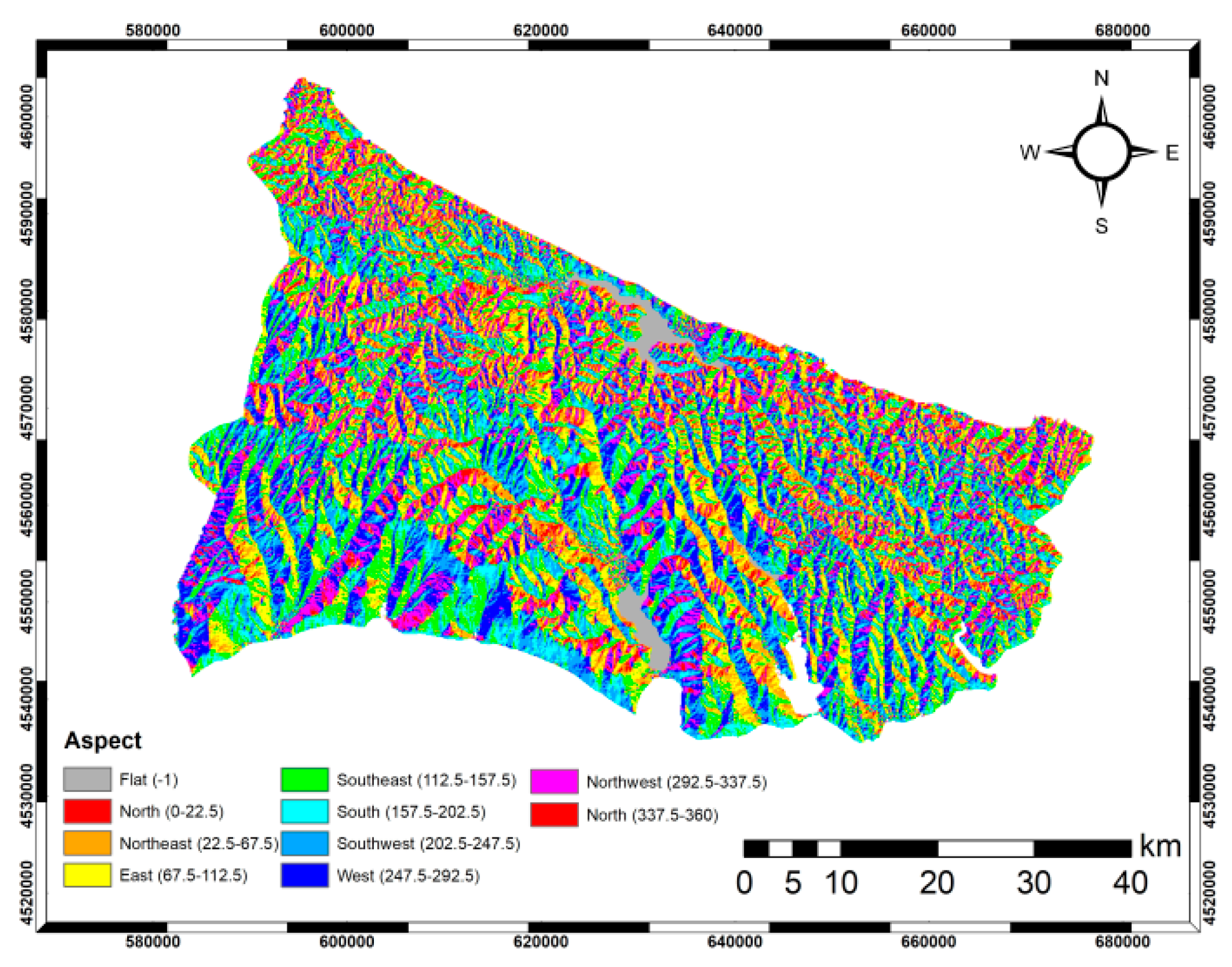
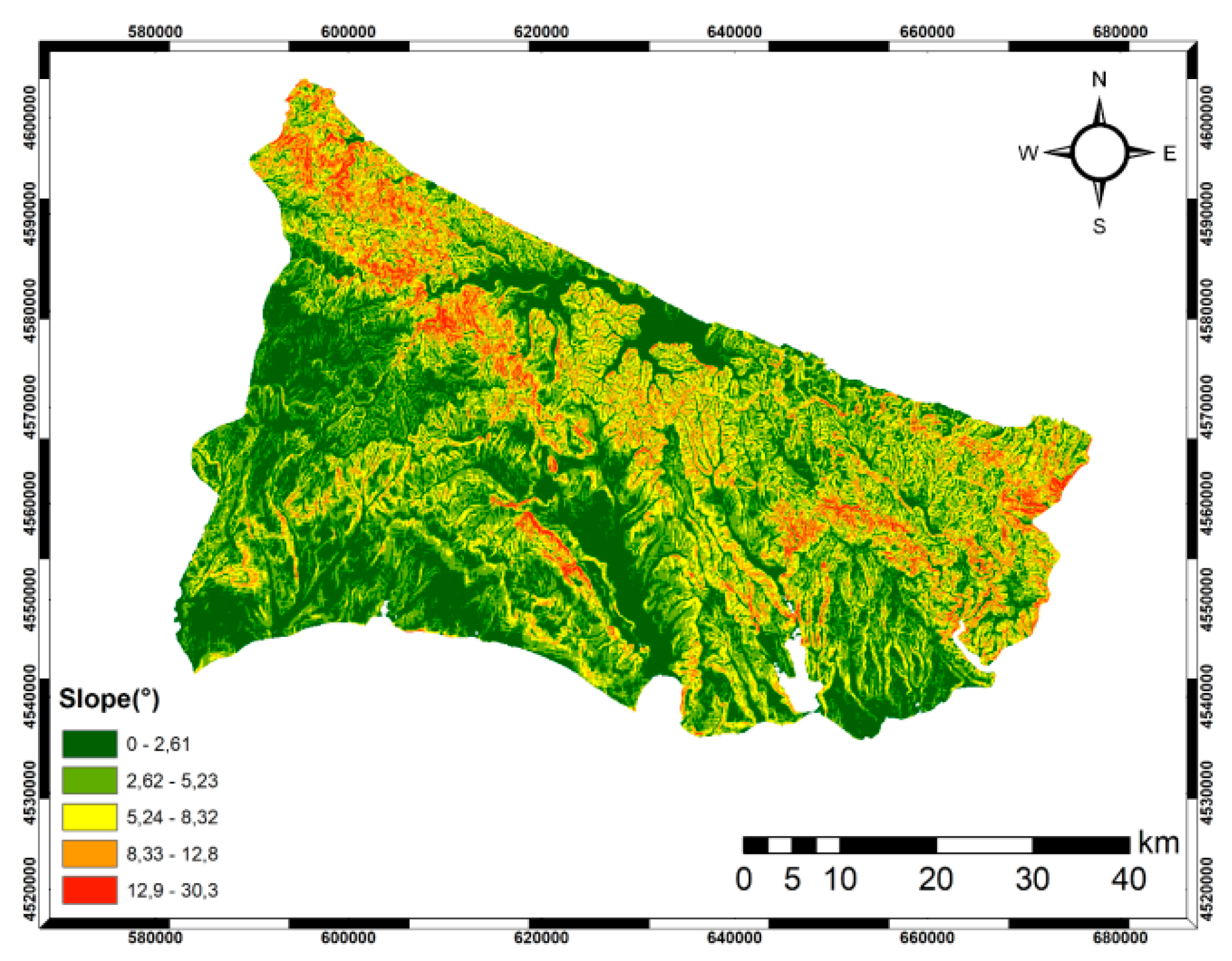
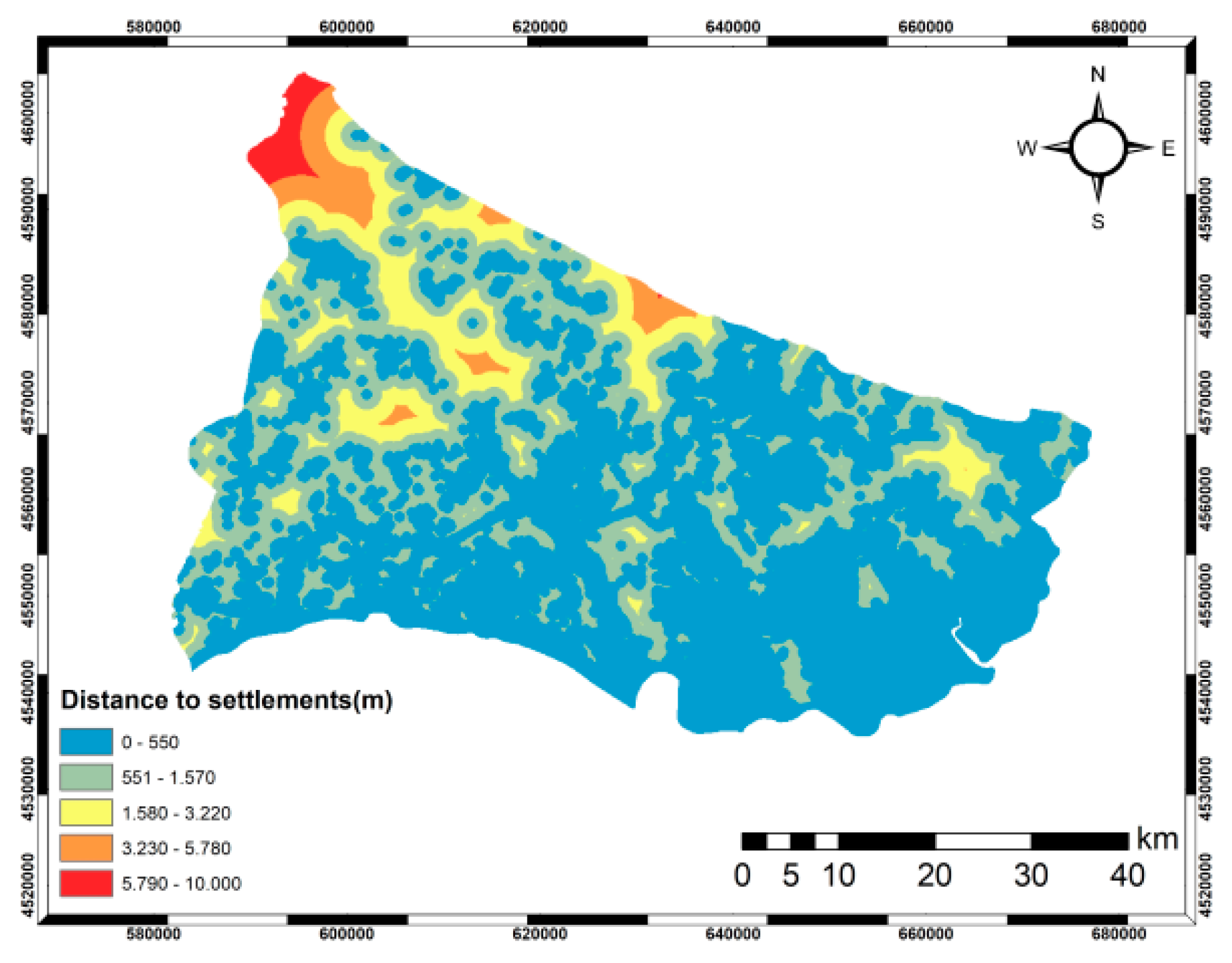
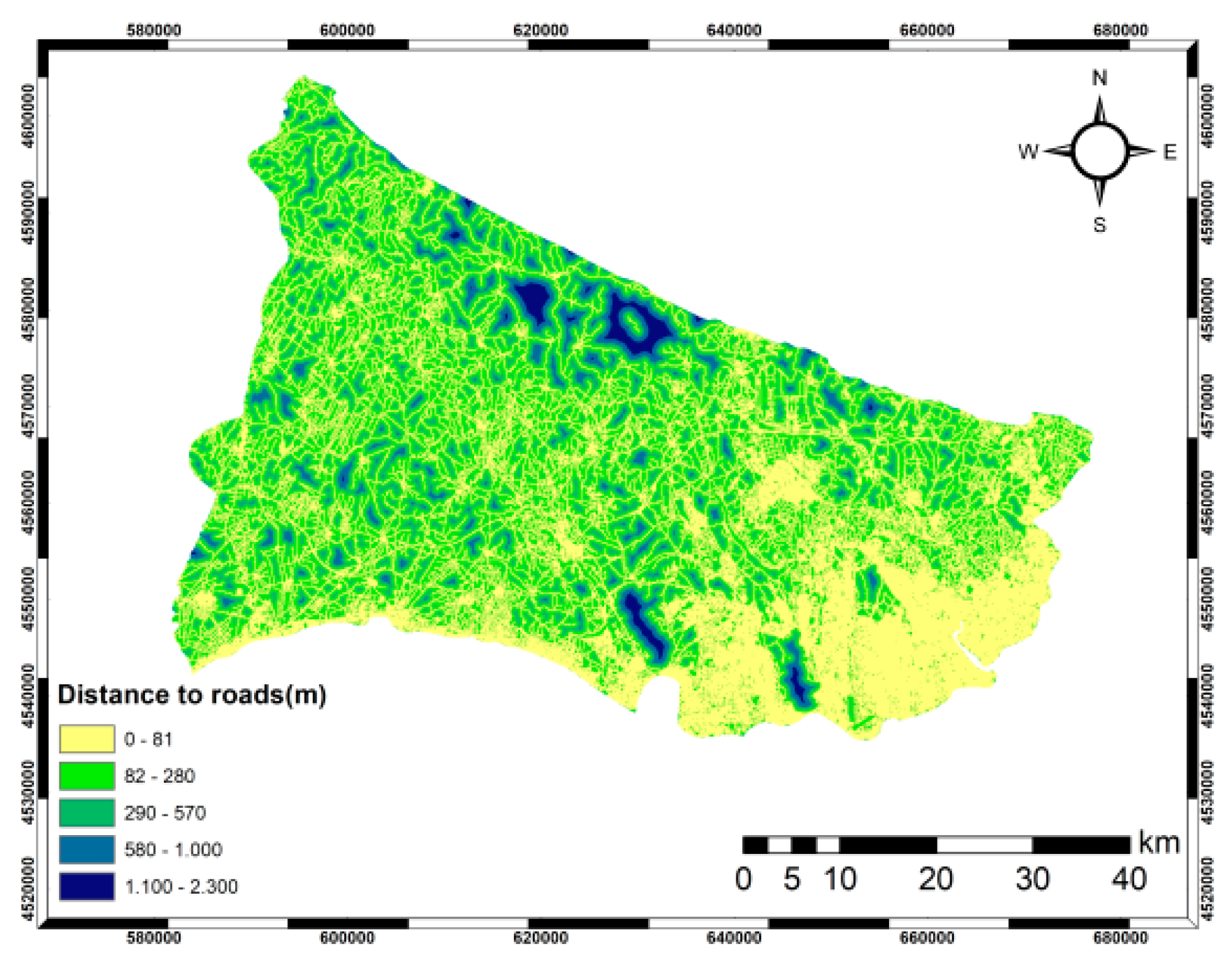
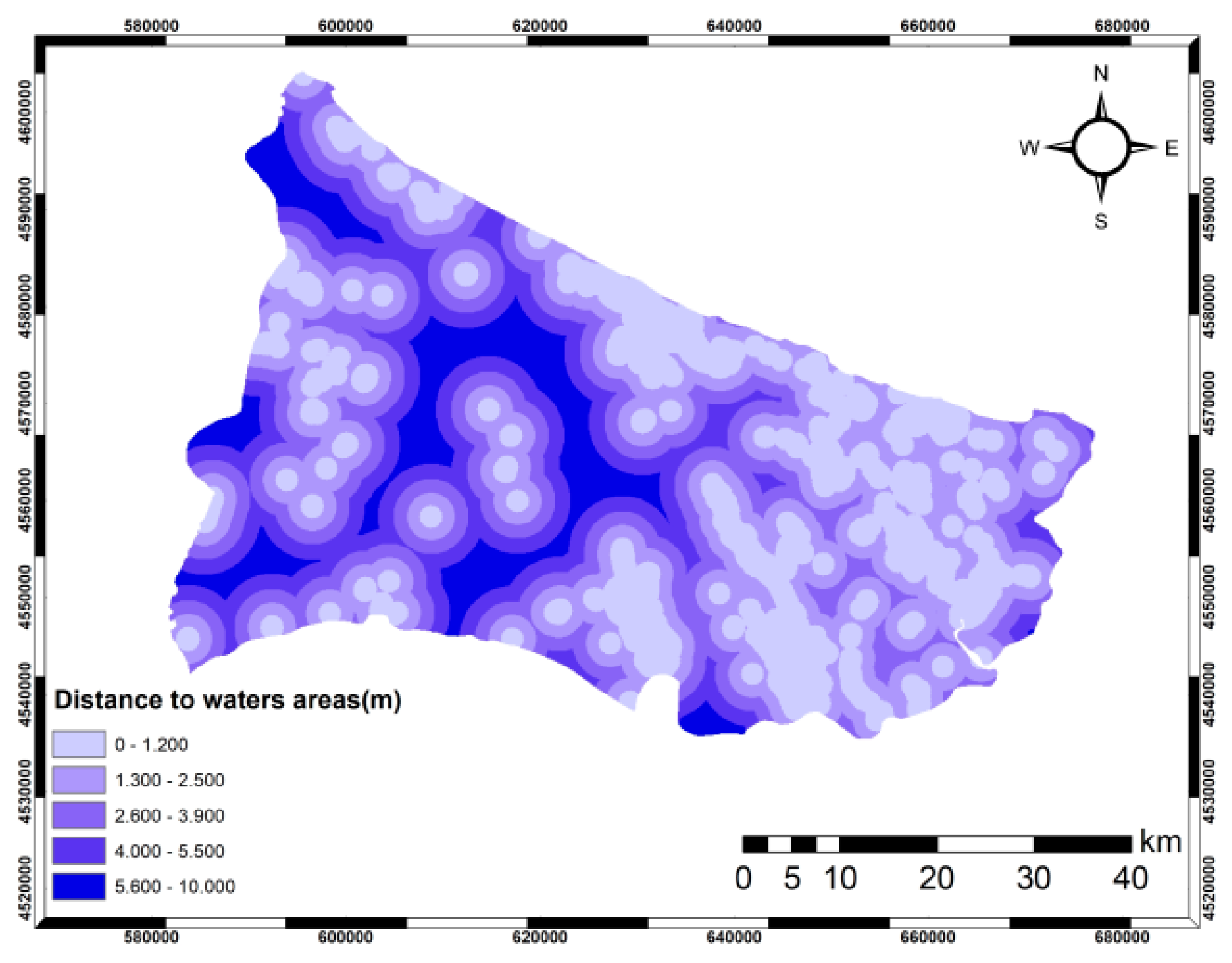
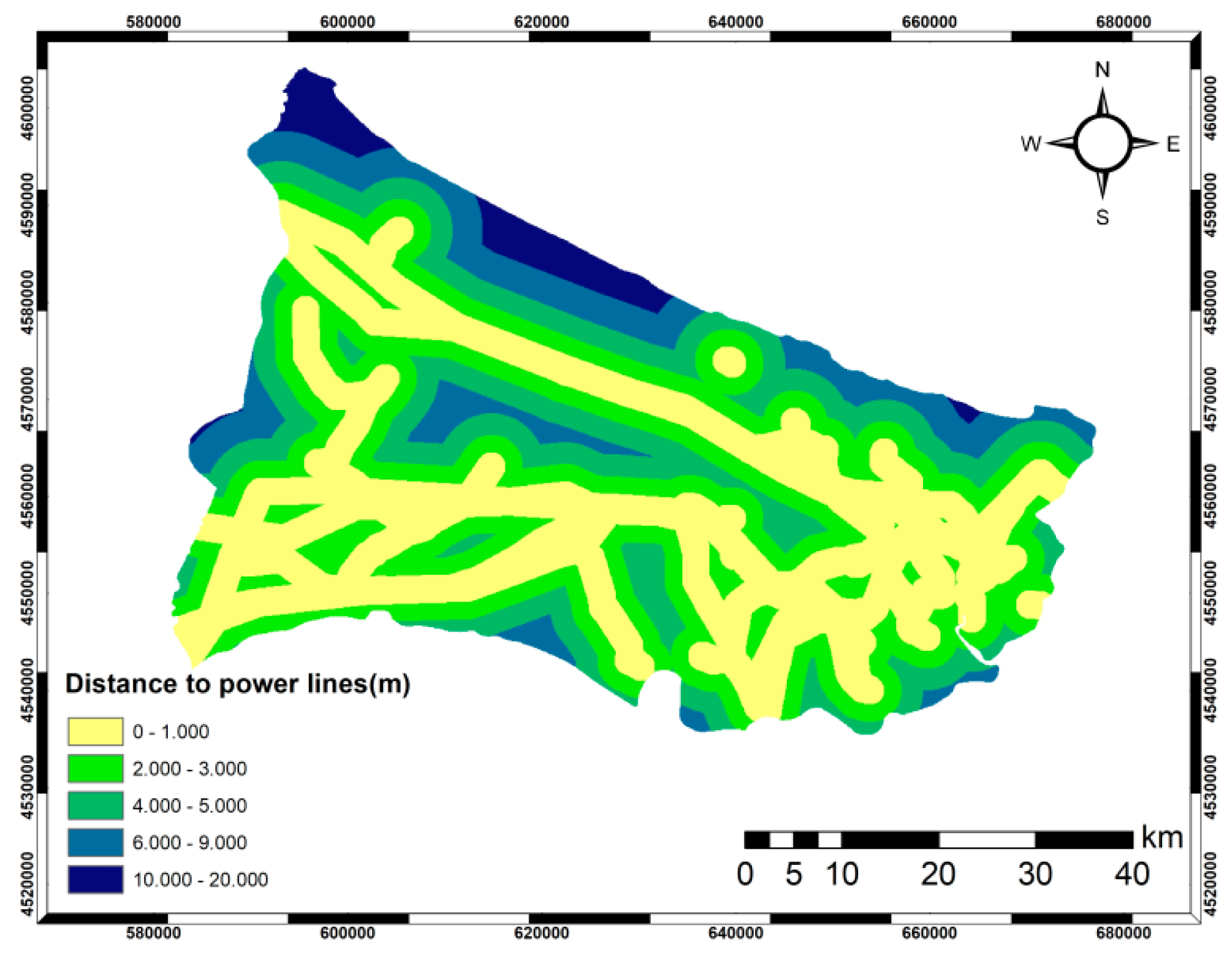
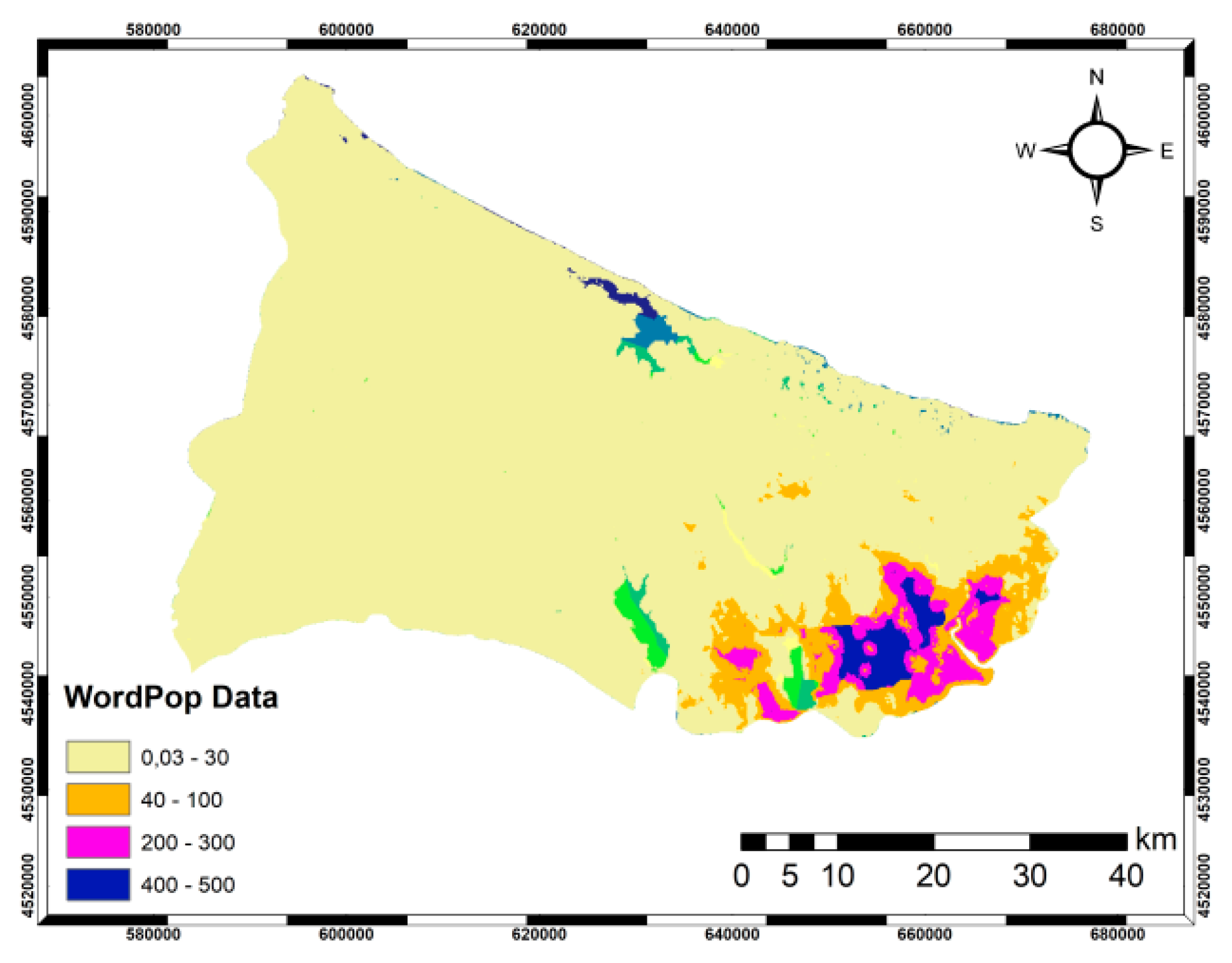
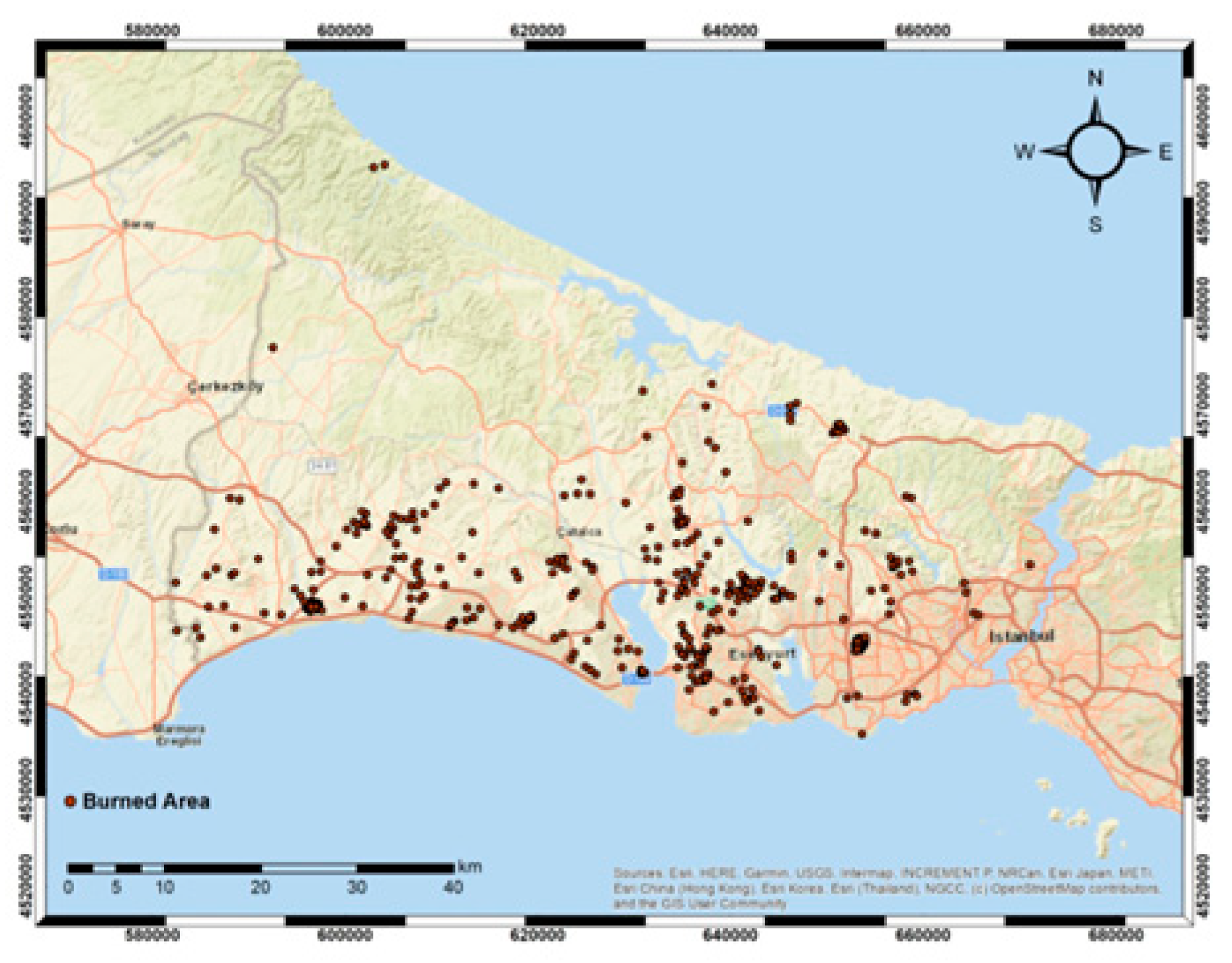
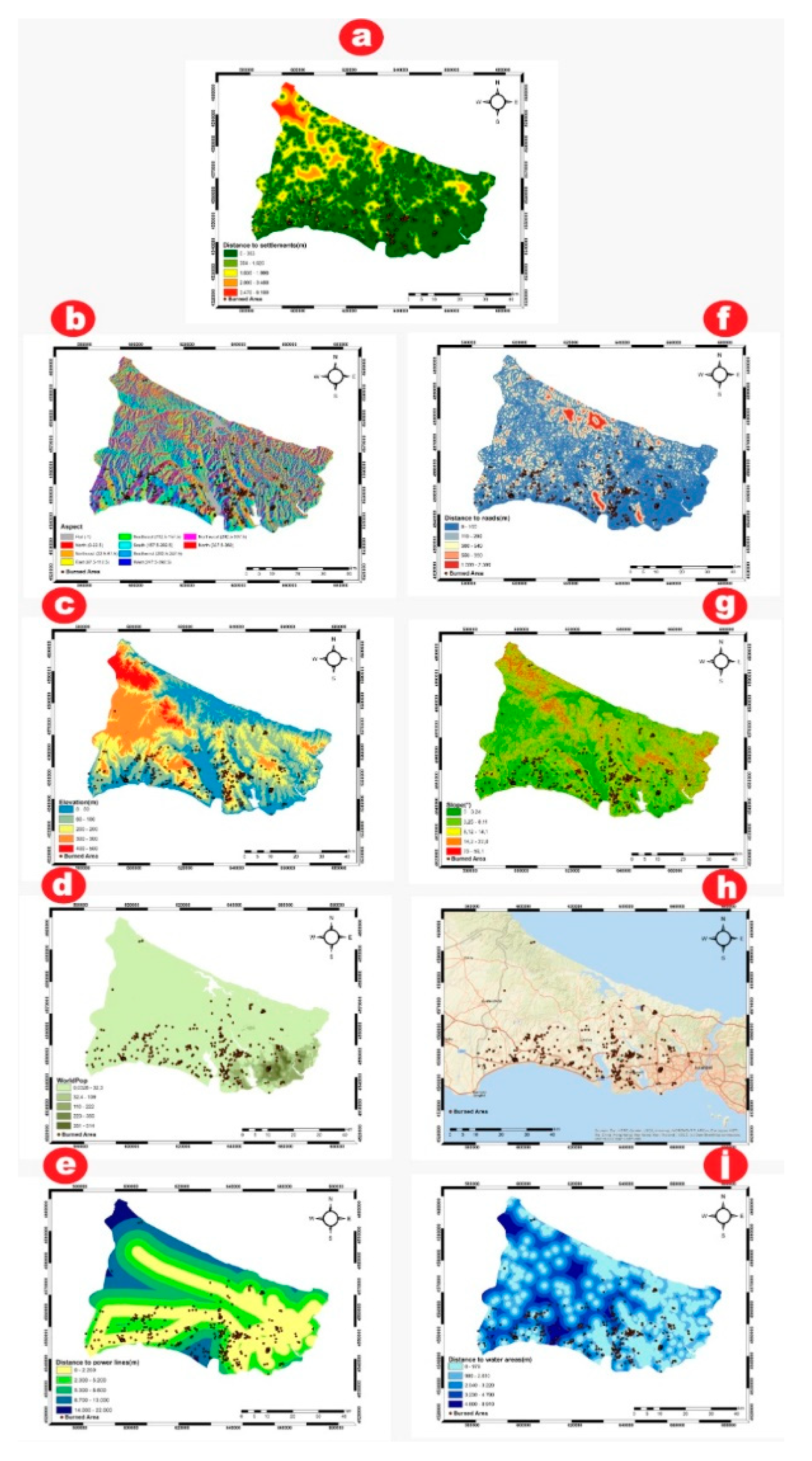

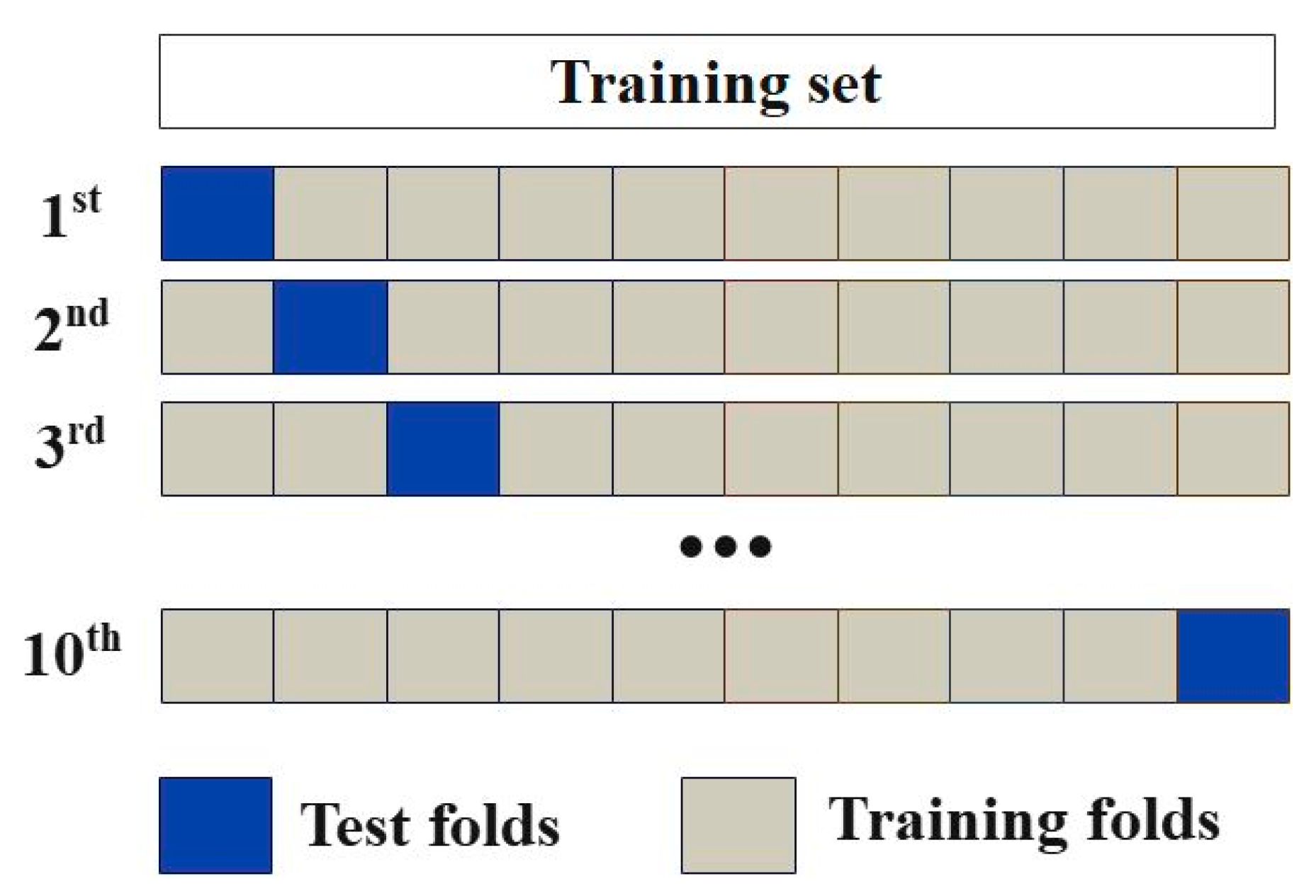
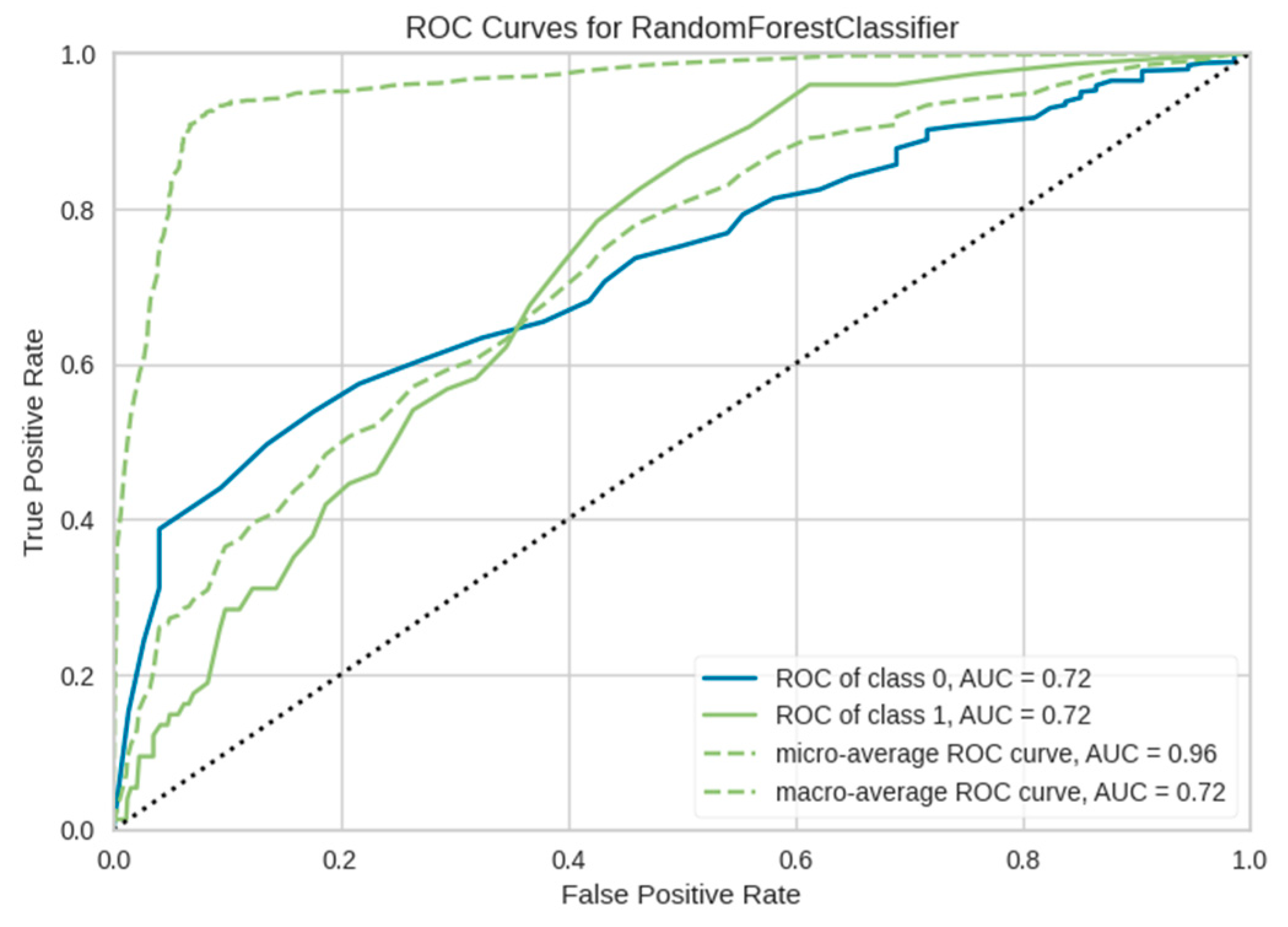
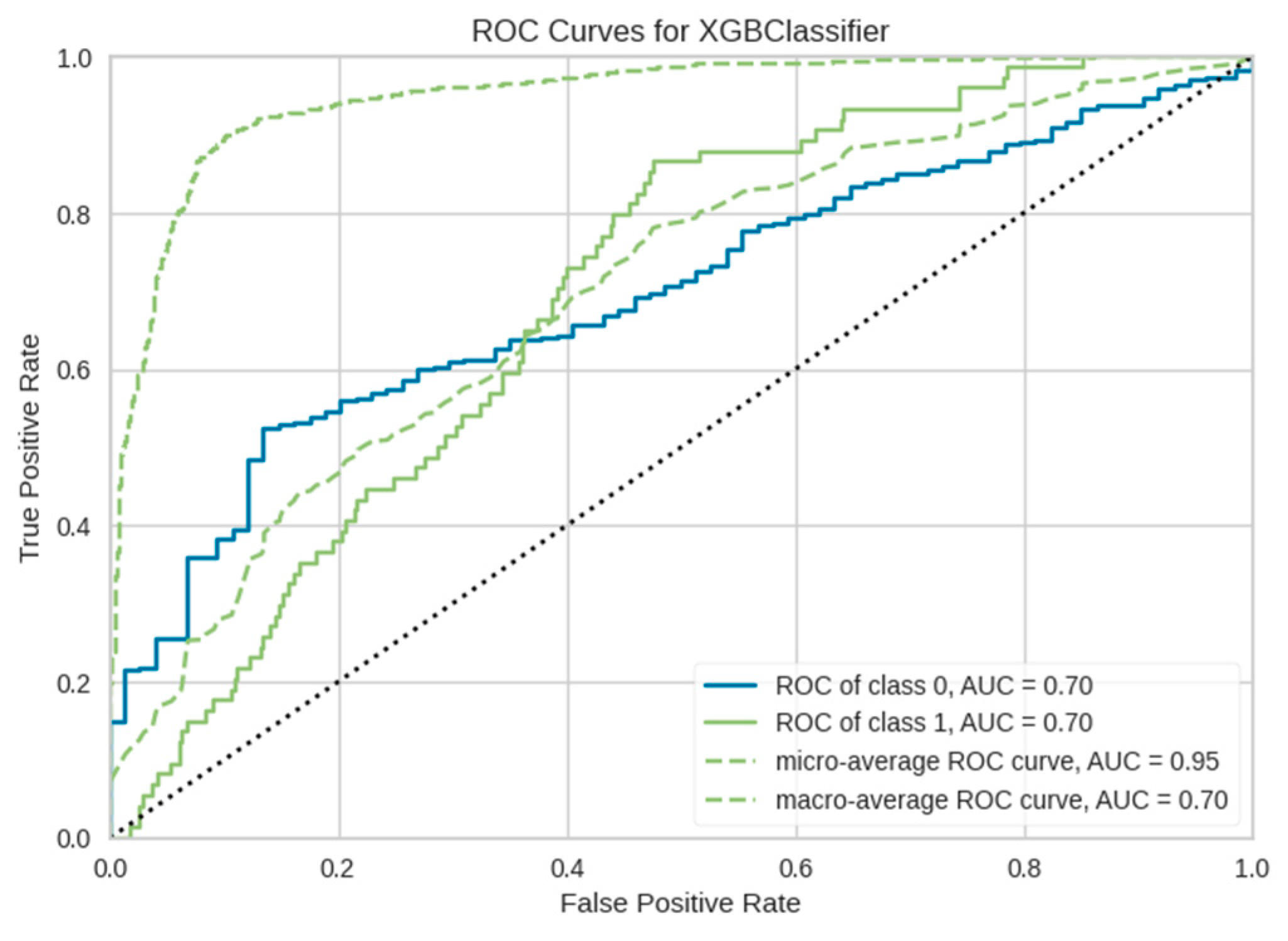
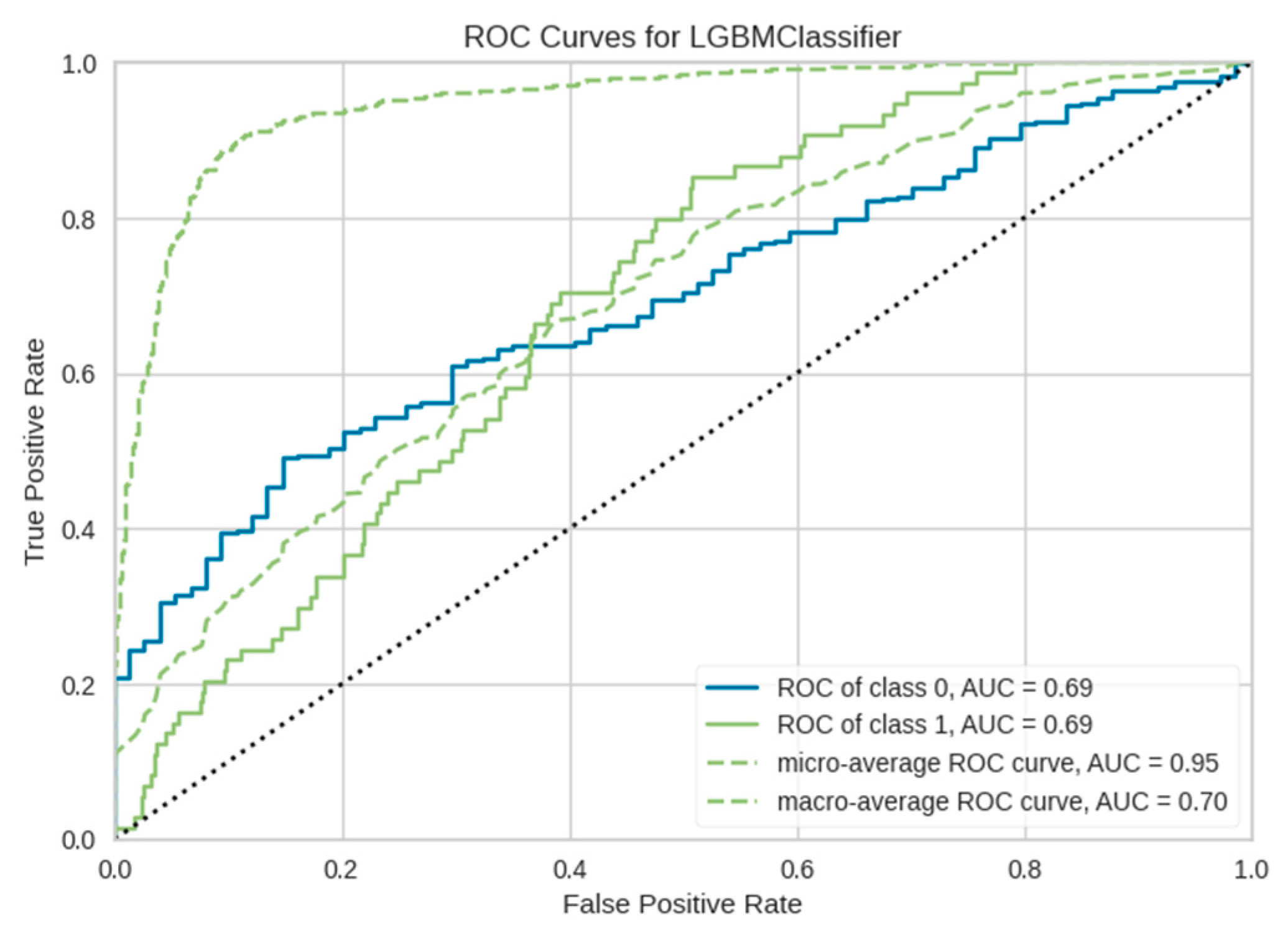
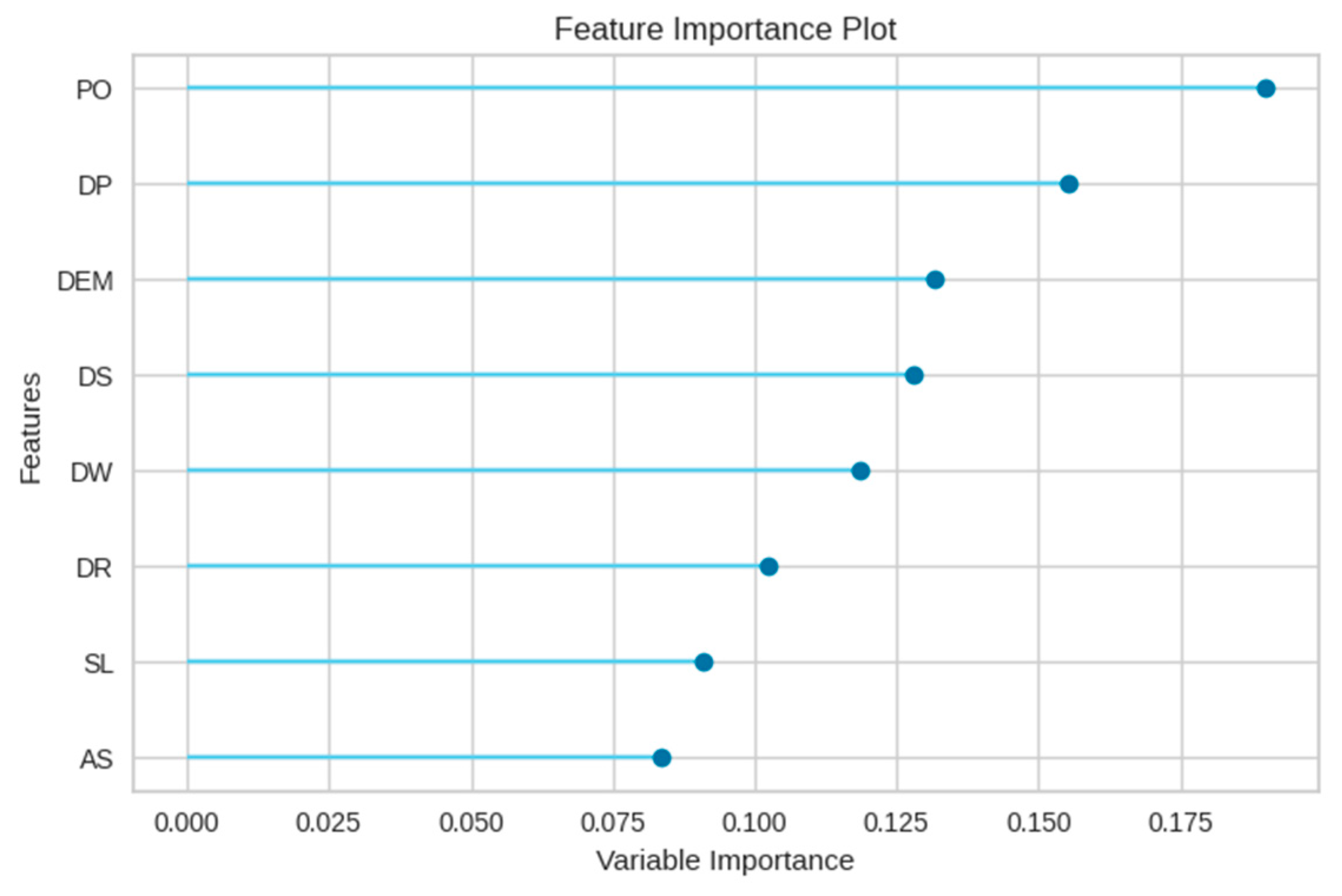
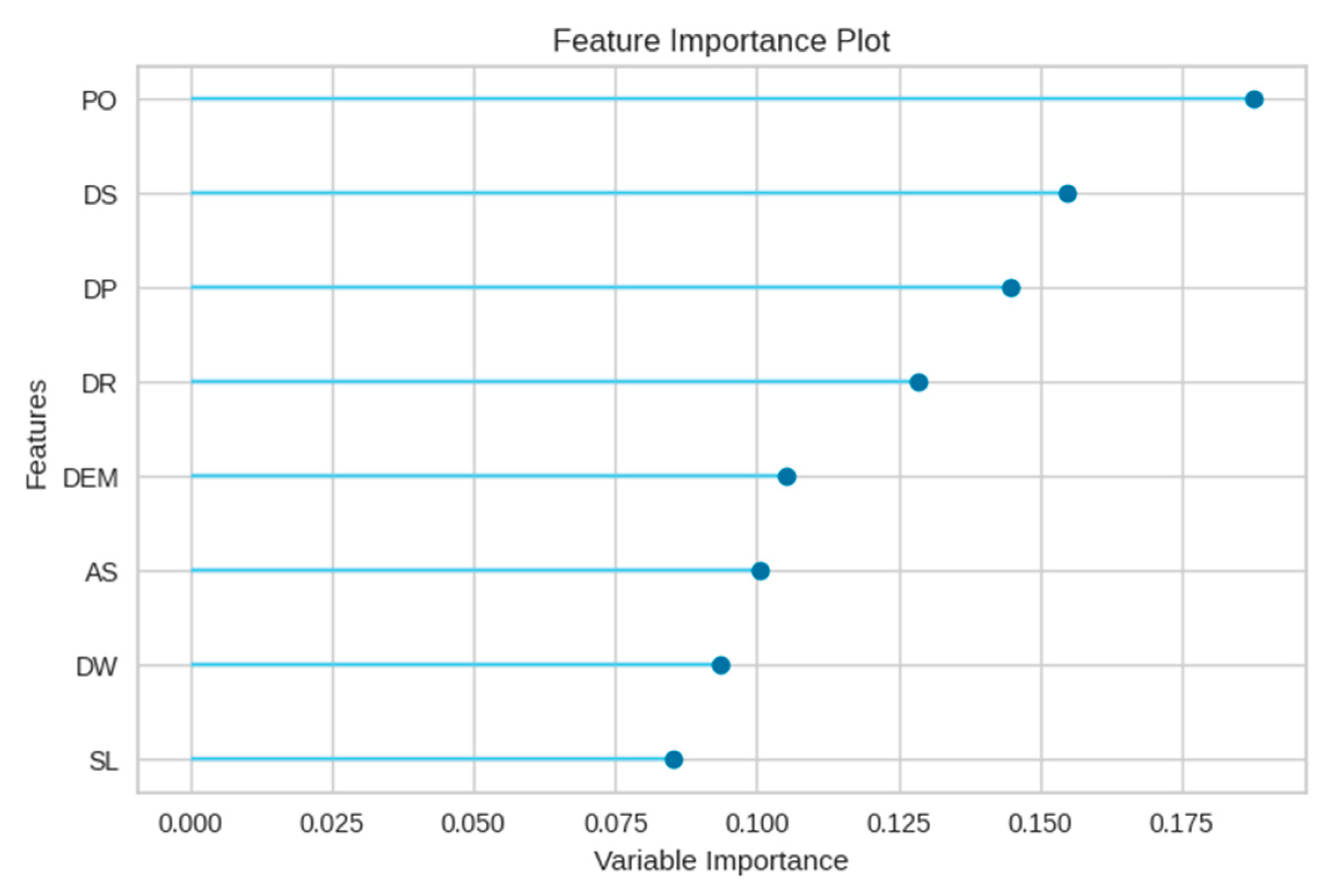
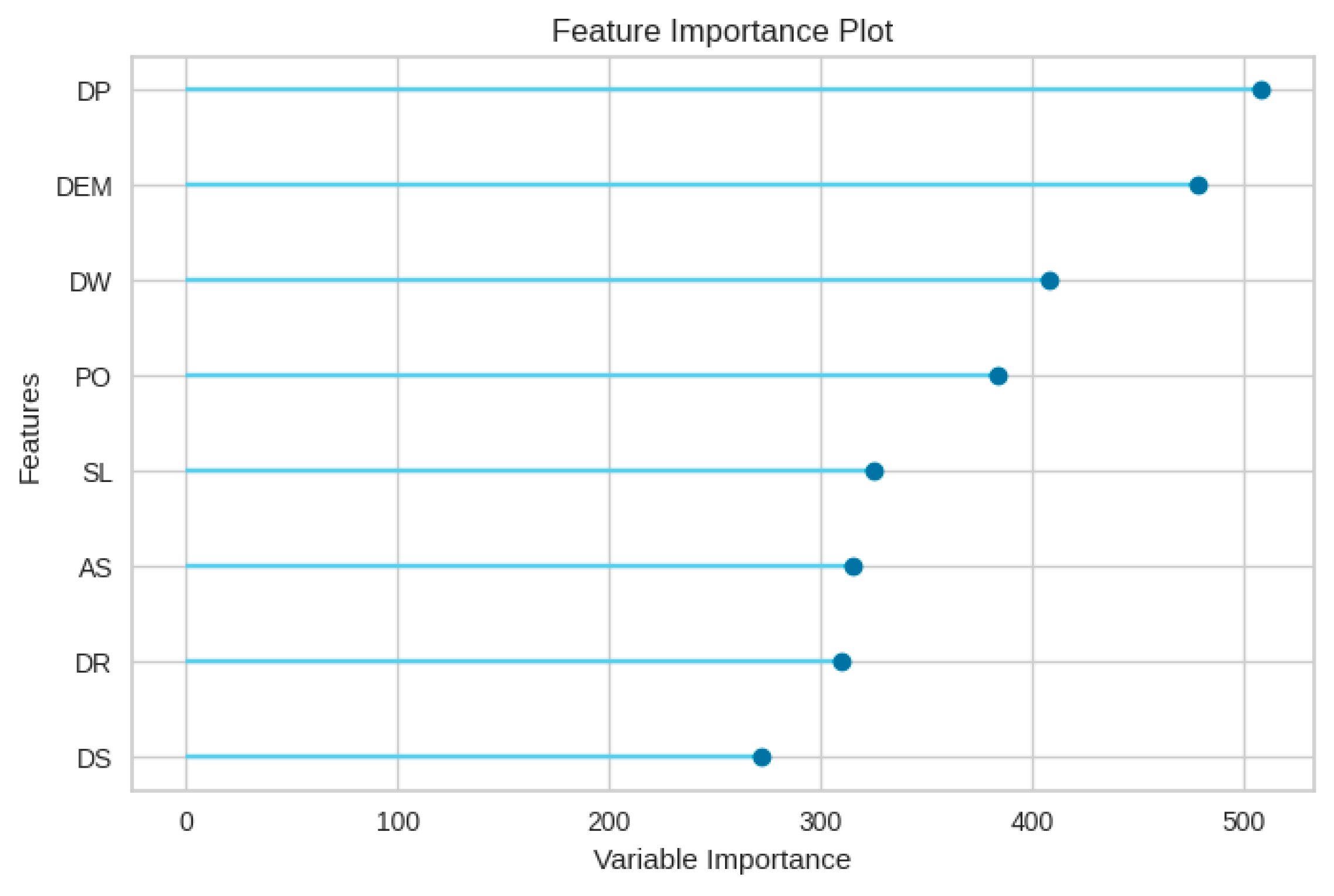
| Slope | Species composition | Topographic Wetness Index (TWI) |
| Aspect | Development Stage | Canadian Forest Fire Weather Index (FWI) |
| Elevation | Solar Radiation | Distance to Fire Response Teams |
| Distance to settlement | Fire regimes (TSF-FR) | Distance to Fire Watch Towers |
| Distance to road | Tree Species Composition | Visibility from Fire Watch Towers |
| Distance to water | Topo-morphology | Distance from the Anti-poaching Camp Shed |
| Population | Land Use | Distance to Previous Fire Points |
| Precipitation | Stand type | Topographic Position Index (TPI) |
| Vegetation Density | Stand age | Tree Stages |
| Temperature | Stand canopy density | Fuel Type |
| Vegetation type | Distance to fields | Humidity |
| Distance from Agricultural Land | Forest Cover | Forest Type |
| Wind speed | Tree Species | Bare soil index |
| Stand Crown closure | Land Surface Temperature | Distance to Tourist Spots |
| Factors | Reference number | |||||||||||||||||||||||||
|---|---|---|---|---|---|---|---|---|---|---|---|---|---|---|---|---|---|---|---|---|---|---|---|---|---|---|
| 12 | 13 | 14 | 15 | 16 | 17 | 8 | 18 | 19 | 7 | 20 | 9 | 21 | 22 | 23 | 24 | 25 | 26 | 27 | 28 | 29 | 30 | 31 | 32 | 33 | 34 | |
| Slope | x | x | x | x | x | x | x | x | x | x | x | x | x | x | x | x | x | x | x | x | x | x | x | x | x | x |
| Aspect | x | x | x | x | x | x | x | x | x | x | x | x | x | x | x | x | x | x | x | x | x | |||||
| Elevation | x | x | x | x | x | x | x | x | x | x | x | x | x | x | x | x | x | x | x | x | ||||||
| Distance to settlements | x | x | x | x | x | x | x | x | x | x | x | x | x | x | x | x | x | x | x | x | ||||||
| Distance to roads | x | x | x | x | x | x | x | x | x | x | x | x | x | x | x | x | x | x | ||||||||
| Distance to water bodies | x | x | x | x | x | x | x | x | x | |||||||||||||||||
| Land use | x | x | x | x | x | x | x | x | x | |||||||||||||||||
| Precipitation | x | x | x | x | x | x | x | x | ||||||||||||||||||
| Vegetation density | x | x | x | x | x | |||||||||||||||||||||
| Temperature | x | x | x | x | x | |||||||||||||||||||||
| Plant type | x | x | x | x | x | |||||||||||||||||||||
| Distance from agricultural land | x | x | x | x | ||||||||||||||||||||||
| Wind speed | x | x | x | x | ||||||||||||||||||||||
| Stand Crown Closure | x | x | x | x | x | |||||||||||||||||||||
| Population | x | x | ||||||||||||||||||||||||
| Topographic Wetness Index | x | x | x | |||||||||||||||||||||||
| Canadian Forest Fire Weather Index (FWI) | x | x | ||||||||||||||||||||||||
| Tree Stages | x | x | ||||||||||||||||||||||||
| Fuel Type | x | x | ||||||||||||||||||||||||
| Humidity | x | x | ||||||||||||||||||||||||
| Forest type | x | |||||||||||||||||||||||||
| Distance to tourist places | x | |||||||||||||||||||||||||
| Distance from the anti-poaching Camp Shed | x | |||||||||||||||||||||||||
| Distance to fields | x | |||||||||||||||||||||||||
| Forest cover | x | |||||||||||||||||||||||||
| Distance to previous fire points | x | |||||||||||||||||||||||||
| Tree species | x | |||||||||||||||||||||||||
| Topographic Position Index (TPI) | ||||||||||||||||||||||||||
| Land surface temperature | x | |||||||||||||||||||||||||
| Bare soil index | x | |||||||||||||||||||||||||
| Species composition | x | |||||||||||||||||||||||||
| Development stage | x | |||||||||||||||||||||||||
| Solar radiation | x | |||||||||||||||||||||||||
| Fire regimes (TSF-FR) | x | |||||||||||||||||||||||||
| Tree species composition | x | x | ||||||||||||||||||||||||
| Topo-morphology | x | |||||||||||||||||||||||||
| Soil use | x | |||||||||||||||||||||||||
| Distance to fire response teams | x | |||||||||||||||||||||||||
| Distance to fire watch towers | x | |||||||||||||||||||||||||
| Visibility from fire watch towers | x | |||||||||||||||||||||||||
| Stand type | x | |||||||||||||||||||||||||
| Stand age | x | |||||||||||||||||||||||||
| Stand canopy density | x | |||||||||||||||||||||||||
| Human Index | x | |||||||||||||||||||||||||
| Count | Mean | Std | Min | 25% | 50% | 75% | Max | |
|---|---|---|---|---|---|---|---|---|
| Slope (SL) (°) | 3455 | 6.34 | 6.54 | 0.00 | 1.30 | 4.28 | 9.09 | 48.60 |
| Aspect (AS) (°) | 3455 | 134.16 | 109.03 | -1.00 | 0.00 | 119.48 | 234.88 | 356.55 |
| Digital elevation model (DEM) (m) | 3455 | 114.56 | 73.68 | 1.00 | 57.00 | 104.00 | 164.00 | 428.00 |
| Distance to powerlines (DP) (m) | 3455 | 4175.25 | 3678.12 | 0.00 | 1315.08 | 3196.81 | 6098.97 | 21801.60 |
| Population (PO) (person) | 3455 | 16.13 | 50.24 | 0.03 | 0.20 | 0.94 | 5.38 | 470.96 |
| Distance to roads (DR) (m) | 3455 | 145.61 | 183.30 | 0.00 | 22.36 | 80.62 | 206.03 | 2046.85 |
| Distance to water areas (DW) (m) | 3455 | 1939.42 | 1396.11 | 0.00 | 853.52 | 1672.00 | 2773.01 | 8547.64 |
| Distance to settlements (DS) (m) | 3455 | 543.93 | 799.76 | 0.00 | 0.00 | 257.10 | 730.31 | 5734.47 |
| Fire Status (FS) (-) | 3455 | 0.07 | 0.26 | 0.00 | 0.00 | 0.00 | 0.00 | 1.00 |
| Platform | Data | Source | Resolution |
|---|---|---|---|
| OSM | Road | http://overpass-turbo.eu | |
| Water Areas | http://overpass-turbo.eu | ||
| Power Line | http://overpass-turbo.eu | ||
| USGS | SRTM | http://earthexplorer.usgs.gov/ | 90 m |
| ArcGIS | Land Cover |
https://livingatlas.arcgis.com/ landcoverexplorer |
10 m - 2021 |
| GEE | WorldPop |
ee.ImageCollection(“WorldPop/ GP/100m/pop”) |
92.7 m |
| FIRMS | MODIS+Aqua Terra Thermal Anomalies (Fire Locations) | https://firms.modaps.eodis.nasa.gov/ | 1 km |
| Predicted value | |||
| Fire (class 1) | Non-Fire (class 0) | ||
| Actual value | Fire (class 1) | True Positive (TP) | True Negative (TN) |
| Non-Fire (class 0) | False Positive (FP) | False Negative (FN) | |
| Model | Accuracy | AUC | Recall | Precision | F1 |
|---|---|---|---|---|---|
| Random Forest (RF) | 0.9293 | 0.7528 | 0.0346 | 0.4000 | 0.0622 |
| Extreme Gradient Boosting (XGB) | 0.9189 | 0.7409 | 0.1546 | 0.3570 | 0.2119 |
| Light Gradient Boosting (LGB) | 0.9107 | 0.7508 | 0.1732 | 0.3454 | 0.2138 |
| RF | XGB | LGB | ||||
| Fold | Accuracy | AUC | Accuracy | AUC | Accuracy | AUC |
| 0 | 0.9298 | 0.6373 | 0.9050 | 0.7278 | 0.9174 | 0.7244 |
| 1 | 0.9339 | 0.7425 | 0.9174 | 0.7746 | 0.9132 | 0.7569 |
| 2 | 0.9298 | 0.7586 | 0.9132 | 0.7762 | 0.8967 | 0.7710 |
| 3 | 0.9421 | 0.8424 | 0.9091 | 0.8434 | 0.9050 | 0.8165 |
| 4 | 0.9256 | 0.8203 | 0.9215 | 0.7619 | 0.9091 | 0.7793 |
| 5 | 0.9215 | 0.7975 | 0.9050 | 0.7371 | 0.9050 | 0.7470 |
| 6 | 0.9256 | 0.8259 | 0.9132 | 0.7956 | 0.9256 | 0.8058 |
| 7 | 0.9256 | 0.7240 | 0.9174 | 0.7612 | 0.9132 | 0.7269 |
| 8 | 0.9253 | 0.6611 | 0.9170 | 0.6799 | 0.9087 | 0.6893 |
| 9 | 0.9253 | 0.7064 | 0.9087 | 0.6197 | 0.9170 | 0.6657 |
| Mean | 0.9285 | 0.7516 | 0.9127 | 0.7478 | 0.9111 | 0.7483 |
| Std | 0.0056 | 0.0669 | 0.0054 | 0.0590 | 0.0077 | 0.0456 |
Disclaimer/Publisher’s Note: The statements, opinions and data contained in all publications are solely those of the individual author(s) and contributor(s) and not of MDPI and/or the editor(s). MDPI and/or the editor(s) disclaim responsibility for any injury to people or property resulting from any ideas, methods, instructions or products referred to in the content. |
© 2023 by the authors. Licensee MDPI, Basel, Switzerland. This article is an open access article distributed under the terms and conditions of the Creative Commons Attribution (CC BY) license (http://creativecommons.org/licenses/by/4.0/).





